Evaluation of an AGC for a Solar Panel as a Receiver in a VLC System Applied to Access Control
Keywords:
Visible light communication (VLC), Light-emitting diodes (LEDs), Optical communication system, Light sensors, solar panel, Automatic gain control (AGC)Abstract
Visible light communication (VLC) technology allows data to be transmitted using the optical power emitted by light-emitting diodes (LEDs). The optical receiver usually employs light sensors such as photodiodes, image sensors, photoresistors or solar panel. In the last decades, VLC technology has explored the use of solar panels as data receivers, since they offer the service of power generation, in addition to, a larger surface area to capture the light beam. In this paper, we present the performance evaluation of a VLC system based on solar panel and automatic gain control (AGC) with application in access control systems. Three experiments are proposed to evaluate the uses of the solar panel as information receiver in VLC systems: bandwidth (BW) estimation, VLC system performance and panel viewing angle variation. As a result, we were able to determine a BW of 10 kHz and 190 kHz considering the panel without AGC and with AGC. In the context of digital modulation, a RS-232 module of an Arduino UNO development system was used in order to execute the technique of intensity modulation and direct detection IM/DD. The NRZ line code of the serial interface was used to modulate the electric current of the LED with a maximum symbol rate of 38400 baud with a data effectiveness of 91%. Furthermore, we found that AGC improves the dynamic range of the solar panel's viewing angle and the performance of the VLC system.
Downloads
References
IEEE Consumer Electronics Society and Institute of Electrical and Electronics Engineers, Implementation of Visible Light Communication System with Auto Gain Control. Osaka, Japan, 2019. doi: 10.1109/GCCE46687.2019.9015589.
J. E. . Mora Arroyo and H. J. . Parra Mogollón, “Asignación dinámica de espectro en redes inalámbricas de nueva generación: una aproximación al estado del arte”, Publ. investig., vol. 15, no. 4, Nov. 2021, doi: 10.22490/25394088.5590.
F. Barnes and B. Greenebaum, “Some Effects of Weak Magnetic Fields on Biological Systems: RF fields can change radical concentrations and cancer cell growth rates,” IEEE Power Electron. Mag., vol. 3, no. 1, pp. 60–68, Mar. 2016, doi: 10.1109/MPEL.2015.2508699.
Kungl. Tekniska högskolan and Institute of Electrical and Electronics Engineers, 2018 10th International Conference on Advanced Infocomm Technology (ICAIT) : 12-15 August, 2018, Stockholm, Sweden.
R. A. Martínez-Ciro, F. E. López-Giraldo, J. M. Luna-Rivera and A. M. Ramírez-Aguilera, "An Indoor Visible Light Positioning System for Multi-Cell Networks," Photonics, vol. 9, p. 146, 2022. doi: 10.3390/photonics9030146
P. Palacios Játiva et al., “A Novel and Adaptive Angle Diversity-Based Receiver for 6G Underground Mining VLC Systems,” Entropy, vol. 24, no. 11, Nov. 2022, doi: 10.3390/e24111507.
S. Fuada, T. Adiono, and A. Pradana, “Employing LM13700 as AGC for mobile visible light communication system,” Int. J. Electr. Electron. Eng. Telecommun., vol. 9, no. 2, pp. 88–93, 2020, doi: 10.18178/ijeetc.9.2.88-93.
J. D. Navarro Restrepo, J. Rojas Úsuga, R. Martínez Ciro, A. Betancur Pérez, and F. López Giraldo, “Caracterización de un conversor de luz a frecuencia TSL235R-LF, para su aplicación en un sistema de comunicación por luz visible,” Rev. EIA, vol. 17, no. 34, pp. 1–7, Aug. 2020, doi: 10.24050/reia.v17i34.1139.
S. K. W. and W. W. K. Choong Il Yeh, Dong Seung Kwon, “An AGC design of mobile cellular systems,” IEEE 60th Veh. Technol. Conf. 2004. VTC2004-Fall, vol. 3, pp. 2134–2137, 2004, doi: 10.1109/VETECF.2004.1400417.
Y. Zhang, X. Jin, W. Jiang, X. Chen, and Z. Xu, “Automatic Gain Control Design for Dynamic Visible Light Communication Systems,” Cornell University Jul. 2020, doi: 10.48550/arXiv.2007.16125
G. Y. Feifei Sun, Danpu Liu, “Particle Filtering Based Automatic Gain Control for ADC-limited Communication,” IEEE 73rd Veh. Technol. Conf. (VTC Spring), pp. 1–5, doi: 10.1109/VETECS.2011.5956342.
F. R. Riccio Anastacio, Seguidor solar a dos ejes cuya posición se calcula utilizando los ángulos de elevación y Azimut del sol en Guayaquil, RECIMUNDO, vol. 6, n.º 1, pp. 225-231, feb. 2022. doi: 10.26820/recimundo/6.(1).ene.2022.225-231
D. McKendry, E. Gu, M. D. Dawson y H. Haas, "Visible light communications in the presence of sunlight," Journal of Lightwave Technology, vol. 31, no. 1, pp. 123-132, Jan.1, 2013, doi: 10.1109/JLT.2012.2223054.


